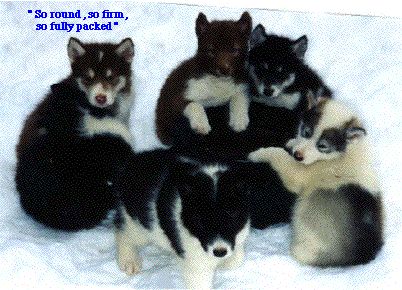Table of Contents
*
Major Announcement
*
IGE Expedition News
*
A Chat About Breeding
*
Honour & Glory
*
Behavioral Notebook
*
Janice Howls
*
IMHO: Pets, et al
Navigating This
Site
Index of articles by subject
Index
of back issues by volume number
Search The
Fan Hitch
Articles
to download and print
Ordering
Ken MacRury's Thesis
Our
comprehensive list of resources
Talk
to The Fan
Hitch
The Fan Hitch
home page
ISDI
home page
Editor's/Publisher's Statement
Editor: Sue Hamilton
Webmaster: Mark Hamilton
The Fan Hitch Website
and Publications of the Inuit Sled
Dog– the quarterly Journal (retired in 2018)
and PostScript – are
dedicated to the aboriginal landrace
traditional Inuit Sled Dog as well as related
Inuit culture and traditions.
PostScript is
published intermittently as material
becomes available. Online access is free at: https://thefanhitch.org
PostScript welcomes your
letters, stories, comments and The editorial
staff reserves the right to edit submissions
used for publication.
Contents of The Fan Hitch Website and its publications are protected by international copyright laws. No photo, drawing or text may be reproduced in any form without written consent. Webmasters please note: written consent is necessary before linking this site to yours! Please forward requests to Sue Hamilton, 55 Town Line Rd., Harwinton, Connecticut 06791, USA or mail@thefanhitch.org

Sketches from the Behavioral Notebook:
The Hole in the Fence
by Sue Hamilton
The picket fence enclosing our smallish back yard had been up for about 10 years when the two litters of 16 ISD pups hit the ground (running and screaming, it seems). From the time the fence was installed until the puppies from hell came into this world, we had 5 litters of Alaskan Malamutes. Although the malamutes didn’t get put outside into the kennel until they were about 5 weeks, and the ISDs were born outside, both they and the ISD pups got their first exposure to the big world of the back yard at about the same time, between 5-6 weeks. Like molecules of gas suddenly released from a pressurized vessel, all pups “expanded” to investigate their grassy surroundings. Sometime within that first 8 days after being released from their pen to explore the yard, the ISD pups did something that had never been done in 10 years by 5 litters of malamutes...they located a small opening in the fence where it was cut away enough to accommodate a downspout to drainage pipe, and then left the confines of the back yard! It was just coming on to dusk when we noticed a mob up pups in the corner next to the house and several small shadowy figures cavorting beyond the picket fence. If this weren’t shocking enough, when we nervously called out, "Heeeeere, puppy, puppy, puppy," the adventurers came back through the hole! This in itself was remarkable when we stopped to consider how many times a malamute puppy of the same age got itself "trapped" behind and open wire kennel door and couldn’t seem to readily find its way around and out to join its littermates.
“"Big deal," you say, "the Hamiltons have demonstrated they have owned incredibly stupid malamutes." "Not necessarily," I would reply, for the very same observation about a hole in the fence was made by a couple who purchased one of these ISD pups. They have had several malamutes over the years. They have a kennel structure as well as a very large fenced in yard, and for many years a hole in the fence they knew about and dismissed because none of their malamute pups so much as entertained the thought of wriggling through. Inside a week, their ISD found the hole and escaped (temporarily).
This is hardly an objective scientific observation from which hard behavioral conclusions can be drawn. Instead, we call these accounts anecdotal. But based on having observed other instances of how these dogs seem to be aware of small details in their environment that our “other breed” misses, I would describe the Inuit Sled Dog as far more perceptive of its surroundings than some other breeds.
Some time after our story of bringing dogs from the high arctic to Connecticut and the subsequent raising of the two litters appeared in an issue of Team and Trail, Mark received a phone call from someone in Ohio who was a breeder of malamutes and an owner of a couple of Inuit Sled Dogs of Greenland origin. This person was delighted to learn she was "not alone" in owning these dogs. But what we found more fascinating was that she recognized in her own ISDs some of the behaviors we described in that article. So even though our experiences are derived from a small number of animals, it appears that other people are corroborating what we have witnessed.
We would appreciate your taking the time to share your experiences with the rest of us. The comparing of notes and amassing of information, even if this is all anecdotal in nature, will prove to be valuable assets in more completely characterizing the Inuit Sled Dog.